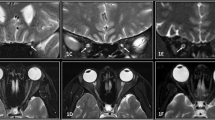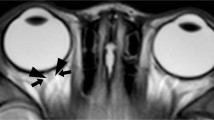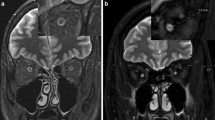Abstract
Background
Optic nerve tortuosity is often reported in children with neurofibromatosis type 1 (NF1).
Objective
To employ quantitative and subjective criteria to assess optic nerve tortuosity in individuals with NF1.
Materials and methods
A retrospective study over a period of 8 years was performed on children with NF1, with and without optic pathway glioma, compared with children without NF1. A tortuosity index was computed for the optic nerve in each child using a high-resolution 3-D T1-weighted magnetization-prepared rapid gradient-echo sequence, which was averaged and compared across groups.
Results
The tortuosity index for subjects with NF1, regardless of an optic pathway glioma, was greater than those without NF1. There was no difference in the tortuosity index between NF1 subjects with optic pathway glioma and NF1 subjects without optic pathway glioma. There was also no correlation between subjective measures of tortuosity and the quantitative scoring (tortuosity index) or between the degree of tortuosity and subject age or gender.
Conclusion
Individuals with NF1 have increased optic nerve tortuosity relative to unaffected individuals. Quantitative tortuosity index is a superior measure to subjective assessment in the evaluation of optic nerve tortuosity in children with NF1.






Similar content being viewed by others
References
Friedman JM, Gutmann DH, MacCollin M et al (1999) Neurofibromatosis: phenotype, natural history and pathogenesis, 3rd edn. John Hopkins University Press, Baltimore
Listernick R, Charrow J, Greenwald MJ et al (1989) Optic gliomas in children with neurofibromatosis type 1. J Pediatr 114:788–792
Listernick R, Louis DN, Packer RJ et al (1997) Optic pathway gliomas in children with neurofibromatosis 1: consensus statement from the NF1 Optic pathway glioma Task Force. Ann Neurol 41:143–149
Guillamo JS, Créange A, Kalifa C et al (2003) Prognostic factors of CNS tumours in Neurofibromatosis 1 (NF1): a retrospective study of 104 patients. Brain 126:152–160
Louis DN, Ohgaki H, Wiestler OD et al (2007) The 2007 WHO classification of tumours of the central nervous system. Acta Neuropathol 114:97–109
Listernick R, Charrow J, Greenwald MJ et al (1994) Natural history of optic pathway tumors in children with neurofibromatosis type 1: a longitudinal study. J Pediatr 125:63–66
King AA, Listernick R, Charrow J et al (2003) Optic pathway gliomas in neurofibromatosis type 1: the effect of presenting symptoms on outcome. Am J Med Genet 122A:95–99
Listernick R, Darling C, Greenwald M et al (1995) Optic pathway tumors in children: the effect of neurofibromatosis type 1 on clinical manifestations and natural history. J Pediatr 127:718–722
Balcer LJ, Liu GT, Heller G et al (2001) Visual loss in children with neurofibromatosis type 1 and optic pathway gliomas: relation to tumor location by magnetic resonance imaging. Am J Ophthalmol 131:442–445
Armstrong GT, Localio AR, Feygin T et al (2007) Defining optic nerve tortuosity. AJNR Am J Neuroradiol 28:666–671
Van Es S, North KN, McHugh K et al (1996) MRI findings in children with neurofibromatosis 1: a prospective study. Pediatr Radiol 26:478–487
DiMario FJ Jr, Ramsby G, Greenstein R et al (1993) Neurofibromatosis type 1: magnetic resonance imaging findings. J Child Neurol 8:32–39
Stumpf DA, Alksne JF, Annegers JF et al (1988) Neurofibromatosis—conference statement. National institutes of health consensus development conference. Arch Neurol 45:575–578
Morris SA, Orbach DB, Geva T et al (2011) Increased vertebral artery tortuosity index is associated with adverse outcomes in children and young adults with connective tissue disorders. Circulation 124:388–396
DiPaolo DP, Zimmerman RA, Rorke LB et al (1995) Neurofibromatosis type 1: pathologic substrate of high-signal-intensity foci in the brain. Radiology 195:721–724
Hyman SL, Gill DS, Shores EA et al (2003) Natural history of cognitive deficits and their relationship to MRI T2-hyperintensities in NF1. Neurology 60:1139–1145
Hyman SL, Gill DS, Shores EA et al (2007) T2 hyperintensities in children with neurofibromatosis type 1 and their relationship to cognitive functioning. J Neurol Neurosurg Psychiatry 78:1088–1091
Kato M, Mizuguchi M, Hattori S et al (1998) Loss of neurofibromin in the leptomeningeal astroglial heterotopia of NF-1. Pediatr Neurol 18:227–230
Kayl AE, Moore BD 3rd, Slopis JM et al (2000) Quantitative morphology of the corpus callosum in children with neurofibromatosis and attention-deficit hyperactivity disorder. J Child Neurol 15:90–96
Moore BD 3rd, Slopis JM, Jackson EF et al (2000) Brain volume in children with neurofibromatosis type 1: relation to neuropsychological status. Neurology 54:914–920
Pride N, Payne JM, Webster R et al (2010) Corpus callosum morphology and its relationship to cognitive function in neurofibromatosis type 1. J Child Neurol 25:834–841
Acknowledgments
We thank Anne C. Albers, PNP, and Mrs. Taylor Ferguson for assistance. The authors also wish to acknowledge the support of the Biostatistics Core, Siteman Comprehensive Cancer Center and NCI Cancer Center Support Grant P30 CA091842.
Conflicts of interest
None.
Author information
Authors and Affiliations
Corresponding author
Rights and permissions
About this article
Cite this article
Ji, J., Shimony, J., Gao, F. et al. Optic nerve tortuosity in children with neurofibromatosis type 1. Pediatr Radiol 43, 1336–1343 (2013). https://doi.org/10.1007/s00247-013-2694-1
Received:
Revised:
Accepted:
Published:
Issue Date:
DOI: https://doi.org/10.1007/s00247-013-2694-1




